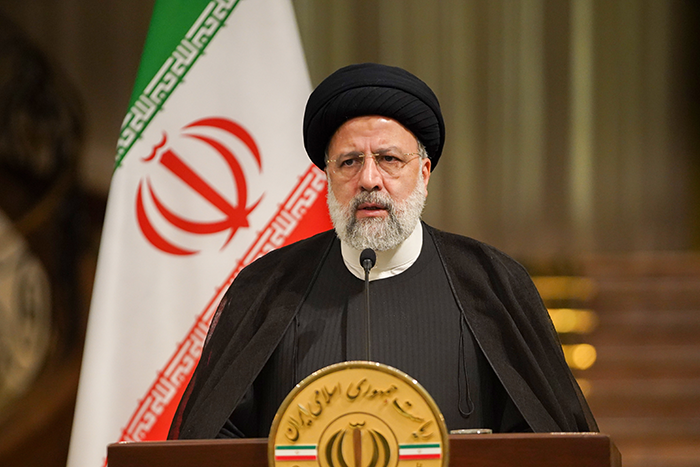Interviews / Middle East / North Africa
24 May 2024
Death of President Ebrahim Raisi: What Political and International Prospects for the Islamic Republic of Iran?

The disappearances of the Iranian president and foreign minister on 19 May 2024 in a helicopter crash shook the country. In a context of regional destabilisation and renewed tensions, particularly with Israel, the election of a new president is now imperative, and the death of Ebrahim Raisi also raises questions about Supreme Leader Ali Khamenei’s future plans for the country. What reactions has the president’s death sparked among the Iranian population? With the presidential election scheduled for 28 June, what are the political and geopolitical prospects for Iran? Answers from Thierry Coville, researcher at IRIS.
How was the announcement of Ebrahim Raisi’s death and the circumstances surrounding it received in Iran? What should be remembered from his presidency?
The announcement of President Ebrahim Raisi’s death on 19 May 2024, following a helicopter crash in Iran’s East Azerbaijan province, was a political shock, as would be the case in any country experiencing a similar incident. The initial reactions from the authorities, including from Supreme Leader Ali Khamenei, were to reassure the public that there would be no consequences for the running of the country. First Vice President Mohammad Mokhber was appointed as interim president pending the new presidential elections at the end of June 2024. It is worth noting that Mokhber was the head of one of Iran’s largest foundations (bonyads), Setad Ejraei Farman Imam — semi-public organisations that own numerous companies, pay no taxes, and report only to the Supreme Leader. His appointment thus confirms the economic and political weight of this semi-public sector (including the bonyads and firms working for the Revolutionary Guards) in the Islamic Republic of Iran. Meanwhile, an investigation was launched by the Chief of Staff of the Armed Forces, Mohammad Bagheri, to determine the causes of the accident. All that can be said for now is that Iran’s civil and military aviation fleet is ageing (one of the oldest in the world…), with US sanctions limiting the country’s ability to purchase planes and spare parts. It should be recalled that US sanctions also prevent Airbus sales to Iran, as at least 10% of the aircraft’s components are American-made. This poses a genuine safety risk for passengers: in 2022, the Aviation Safety Network recorded nearly 1,800 accidents since the revolution.
During his presidency, Ebrahim Raisi proved to be a loyal executor of Supreme Leader Ali Khamenei’s directives. Unlike his predecessors, there was not a single moment of apparent disagreement between the Supreme Leader and Raisi. Raisi will of course be remembered for having led a brutal crackdown on the “Women, Life, Freedom” protest movement in 2022 (with over 500 demonstrators killed) and for his inability to offer any response to the crisis other than security measures. This repression deepened the “fractures” within Iranian society and explains why a number of people, including the families of repression victims, openly expressed satisfaction at his death. Other criticisms focused more on his economic policies. Raisi was elected on a promise to improve Iran’s economic situation, claiming that former president Hassan Rouhani was wrong to link all of Iran’s economic woes to the reimposition of US sanctions after Donald Trump’s withdrawal from the nuclear deal in 2018. However, despite such promises, inflation remained high throughout Raisi’s presidency — close to 50% since 2021, though it slowed to around 30% in early 2024. Raisi was thus at odds with his pre-election rhetoric, eventually realising he could not meaningfully reduce inflation as long as US sanctions remained in place. He was also criticised for economic missteps, such as the elimination in 2022 of currency subsidies for essential imports (wheat, oil, medicine), which further fuelled already high inflation.
What political consequences can be expected in Iran, given that Raisi was “tipped” to succeed Ayatollah Khamenei and that elections will be held on 28 June?
One must remain cautious here. It is true that Ebrahim Raisi was cited as a possible successor to Supreme Leader Ali Khamenei. On the other hand, he was not the only one. Some argue that his “poor” record on the economic front as president may have undermined his credibility as a future Supreme Leader. Furthermore, since the 1979 revolution, several figures have been mooted as potential successors to the Supreme Leader only to fall out of favour shortly thereafter. What is certain is that the succession of Ali Khamenei, when it occurs, will be a major event on the Iranian political scene. It is worth noting that the Assembly of Experts — whose role includes selecting the next Supreme Leader and of which Raisi was a member — has just held its first session since the March 2024 elections that determined its new composition. All members share a radical political stance that strongly supports the principle of Velayat-e Faqih (the supremacy of religious authority over politics), and all figures not meeting this criterion, such as former president Hassan Rouhani, were excluded.
As for the upcoming presidential elections, everything will depend on the decisions made by Supreme Leader Ali Khamenei. If he believes the country’s overall strategy should remain unchanged, he will favour a candidate resembling Raisi — a radical who will continue the previous policies, particularly in terms of repression and enforcing the compulsory hijab for women. Otherwise, he may decide that the political crisis gripping Iran since 2022 must be addressed, and that a figure with a more pragmatic approach is needed to reduce the rift between the government and a large portion of society, while also continuing the ongoing dialogue with the United States on regional conflicts and the nuclear issue. In any case, the next president will adhere closely to the radical line supporting Velayat-e Faqih.
In a particularly tense regional climate, could a change of president really weaken Iran internationally and increase the current instability in the Middle East?
That seems unlikely. Iran’s regional strategy is primarily defined by Ali Khamenei and his advisors. Moreover, Ali Bagheri Kani, appointed interim foreign minister after the death of Hossein Amir-Abdollahian (who also perished in the helicopter crash), is part of the camp defending Velayat-e Faqih and the so-called “Axis of Resistance.” He served as campaign manager for Saeed Jalili — a well-known figure in this movement — during the 2013 presidential elections. He also oversaw nuclear negotiations in Raisi’s government, illustrating the continued importance of this issue for Iran.
Iran’s international strategy will remain focused on defending the Axis of Resistance while gradually strengthening previously strained relations with Gulf Cooperation Council countries such as Saudi Arabia, the United Arab Emirates, and Kuwait. On the international stage, a key priority is maintaining contact with the United States, notably to prevent regional conflicts from “spilling over” and in anticipation of “future” negotiations on the nuclear issue. It is worth noting that all the leaders of the Axis of Resistance were present at Raisi’s funeral in Tehran, and that Saudi Arabia, the UAE, and Kuwait sent their respective foreign ministers.

